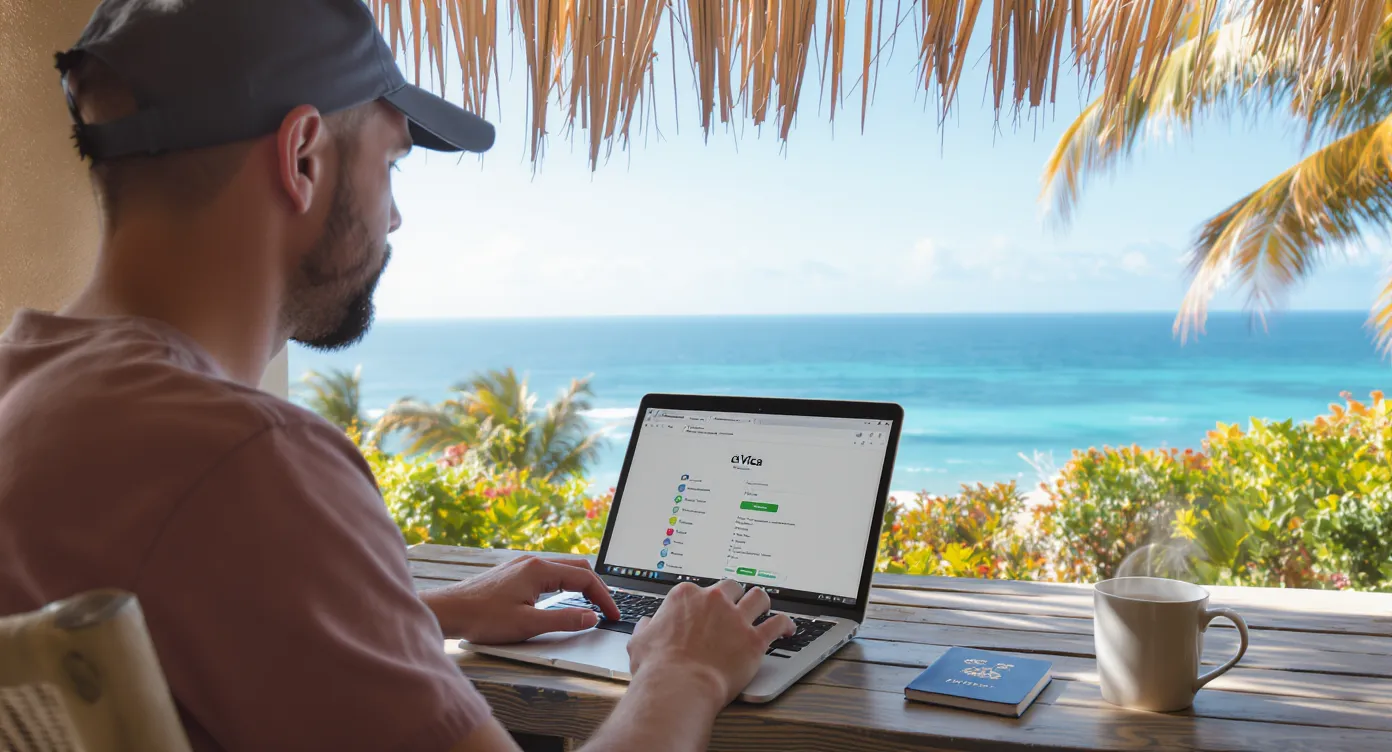Remote Work on a Tourist Visa: Risks, Alternatives, and Legal Digital‑Nomad eVisas

The global surge in remote work has blurred the line between vacation and vocation. Packing a laptop next to your swimsuit and answering Slack from a beach café sounds harmless—until an immigration officer decides it looks like illegal employment. Working on a tourist visa can carry serious consequences, yet thousands of travelers still assume it’s a harmless grey area. This guide unpacks the legal risks, explores legitimate alternatives, and shows how specialized digital-nomad eVisas open doors to truly location-independent lifestyles.
1. Tourist Visa vs. Remote Work: Why the Distinction Matters
Most tourist visas (or visa-waiver stamps) explicitly prohibit “gainful employment.” Immigration codes usually define work as any activity that generates income, regardless of whether the money lands in a foreign or domestic bank account.
| Permit Type | Typical Purpose | Paid Work for Foreign Employer? | Local Payroll Allowed? | Maximum Stay |
|---|---|---|---|---|
| Tourist Visa / ETA | Leisure, family visits, short study | Not permitted | No | 30–180 days (country-specific) |
| Short-Term Business Visa | Conferences, meetings, market research | Usually permitted if paid abroad | No local payroll | 30–90 days |
| Digital-Nomad Visa / eVisa | Remote work for foreign employer or own company | Permitted | Still no local payroll | 6–24 months, renewable |
Key takeaway: If you open your laptop to work on a tourist visa, you’re usually violating entry conditions—even if the client is in your home country.
Penalties You Could Face
- Immediate visa cancellation and deportation
- Multi-year re-entry bans
- Fines that can exceed US $2,000 in some jurisdictions
- Employer liability under Posted Worker or PE (Permanent Establishment) rules
In Bali alone, Indonesian authorities expelled more than 200 foreigners in 2024 for social-media posts advertising remote-work services, according to the Jakarta Post. Similar crack-downs occurred in Mexico’s Quintana Roo, Thailand’s Chiang Mai, and Portugal’s Algarve.
2. Common “Grey-Area” Myths Debunked
- “I’m just answering email—no one will care.” Many border agents do care. Even social-media photos that look like professional shoots can trigger investigations.
- “I’m paid outside the country, so it’s legal.” Payment location rarely overrides immigration rules. Activity within the territory is what matters.
- “A business visa covers remote work.” Business visas allow meetings or conferences, not daily remote employment.
3. Legitimate Alternatives to Tourist Visas
3.1 Short-Term Business Visas
Useful for on-site meetings or conferences. They still prohibit salary or long-term work but can cover brief project visits. Processing is often quicker than a work permit, and many countries now issue them as eVisas.
3.2 Freelancer or Self-Employment Permits
Germany’s “Freiberufler” or Czechia’s “Živnostenský” visa allow freelance work for local and foreign clients but require tax registration and, often, translated business plans.
3.3 Digital-Nomad Visas and eVisas
Over 60 countries now offer dedicated remote-work permits, many fully online. They strike a balance between tourist simplicity and work-permit legality.
| Country | Visa Name | Min. Monthly Income (USD) | Validity | Processing Time |
|---|---|---|---|---|
| Portugal | D8 Digital Nomad | $3,300 | 1 year, renew | 30–60 days |
| Spain | Digital Nomad Visa | $2,600 | 1 year, renew to 5 | 20–45 days |
| Estonia | Digital Nomad Visa | $4,550 (gross) | 1 year | 15–30 days |
| Costa Rica | Rentista/Remote Worker | $3,000 | 2 years | 30–60 days |
| Indonesia | Second-Home Visa (Nomad track) | $2,000 bank balance × 12 | 5 years | 10–20 days |
| UAE | Virtual Working Programme | $3,500 | 1 year | 10–15 days |
| Barbados | Welcome Stamp | $50,000 annual income | 12 months | 5–10 days |
| Georgia | Remotely From Georgia | $2,000 | 1 year | 10 days |
Data verified October 2025. Always check official portals for updates.

4. How to Qualify for a Digital-Nomad eVisa
While requirements vary, most programs share six core pillars:
- Proof of steady foreign income above a stated threshold (often 2–3× local median salary).
- Valid health or travel insurance that covers the destination for the full stay.
- Clean criminal-record certificate (FBI, ACRO, etc.) issued within the last 90 days.
- Remote employment or business ownership documentation—employment contract, client invoices, company certificate.
- Accommodation details for at least part of the stay—hotel booking, lease, or invitation letter.
- Electronic application & fees ranging from $50 (Georgia) to $2,000 (Cayman Islands Global Citizen Concierge).
Because more governments are digitizing entry permits, many applications can be completed entirely online—no embassy visit required. SimpleVisa’s API already surfaces eligibility rules for dozens of digital-nomad schemes and can pre-fill forms during a flight or hotel checkout.
Typical Timeline
- Day 0: Gather documents, notarize if needed.
- Day 3: Submit online application and pay via card.
- Day 7 – 30: Government review. Some countries now run automated AML and security checks similar to ETAs.
- Day 30 – 45: Receive eVisa PDF or digital ID. Print or store on your device.
![]()
5. Tax, Social-Security, and Employer Considerations
Securing the correct visa is only half the compliance story:
- Tax residency often triggers after 183 days of physical presence. A nomad visa does not automatically exempt you from local income tax.
- Employer of Record (EOR) solutions can shield a company from Permanent Establishment risks if staff spend months abroad.
- Social-security totalization agreements may let you stay on your home plan, but some nomad schemes (e.g., Spain) require local contributions.
- Digital-nomad visas in Portugal and Greece offer flat-rate tax programs that cap income tax at 15–20 percent—attractive but still mandatory to declare.
Always consult a cross-border tax advisor before relocating a payroll or freelance income stream.
6. How Travel Brands Can Support Nomads—and Earn Ancillary Revenue
Airlines, OTAs, and coworking platforms increasingly add visa guidance to their funnels. By integrating SimpleVisa’s no-code widget or Flights-to-Visas API, partners can:
- Display eligibility and required income thresholds during booking
- Offer a paid digital-nomad eVisa service that boosts ancillary revenue by up to $18 per booking (SimpleVisa partner data, Q3 2025)
- Reduce post-booking support tickets and denied boardings related to visa confusion
Frequently Asked Questions
Can I work remotely on a tourist visa if I’m only staying two weeks? No. Length of stay doesn’t override visa conditions. Any remunerated activity is technically disallowed.
Does a digital-nomad visa let me take local freelance gigs? Usually not. Most programs restrict you to foreign-sourced income. Check each country’s labor code.
What happens if I’m caught working on a tourist visa? Possible outcomes include visa cancellation, fines, deportation, and multi-year bans. Some countries may also flag your passport in shared immigration databases.
Are digital-nomad eVisas hard to get? Approval rates are high if you meet income and documentation requirements. Programs like Georgia’s and Barbados’s routinely exceed 90 percent approval, according to official statistics.
Can SimpleVisa handle my application? SimpleVisa provides the technology behind many travel websites and agencies. If your booking platform offers a “Remote-Work Visa” add-on powered by SimpleVisa, you can complete the process without leaving the site.
Ready to Go Legit—And Stay Longer?
Working remotely shouldn’t feel like smuggling a keyboard across borders. Secure the right digital-nomad eVisa and turn precarious stopovers into carefree long-term stays. Look for the Apply with SimpleVisa button on your favorite travel site—or ask your HR and travel provider to integrate SimpleVisa’s API for seamless, compliant journeys.